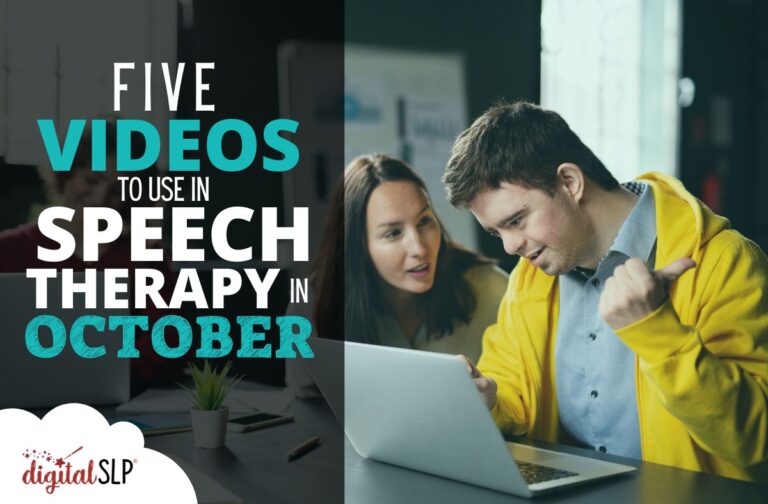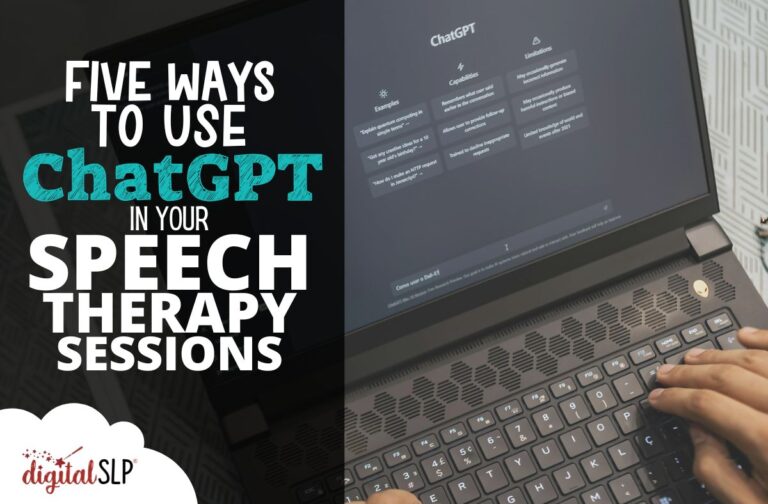When October arrives, it can feel like we’re starting a race to the end of the year! Fortunately, these new video recommendations invite us to slow down, pay attention, and stay curious.
As always, a quick reminder: I watched all of the videos and found them to be worthwhile, but everyone’s needs are different, so please preview any video fully before sharing it with students.
Length: 5 minutes
Ages: 6th–8th grade
October is Emotional Wellness Month, a wonderful opportunity to review concrete strategies for coping with big feelings. This video from mental health nonprofit Child Mind Institute offers middle school–friendly tips that students can begin to use right away.
As students learn emotional regulation skills, they can also work on speech and language goals, including:
- Adjectives: This video emphasizes the importance of noticing the connection between body sensations and emotions, but this skill may not be easy for students, especially if they struggle with interoception. You could provide a list of sensation-focused adjectives (e.g., “buzzy,” “constricted,” “jumpy,” “shaky”) and do regular body check-ins to help them get started.
- Define and describe: As this video opens, a student shares her definition of the word “feeling.” Students could create their own definitions after watching this model.
- Personal narrative: The students in the video share poignant stories about their most common feelings, and you could invite your students to do the same.
- Social-emotional learning: Around the 4:30 mark, a student talks about a time when he felt terrible about himself and his appearance. You could ask students to consider how they would respond/what they would say if this student were their friend.
- Extension: The Child Mind Institute has an excellent educator implementation guide with additional ideas for how to use this video.
Length: 9 minutes
Ages: 1st–5th grade
October is also AAC Awareness Month, and this vibrant picture book from autistic parent Tiffany Hammond gently and skillfully disrupts common misconceptions about AAC, while encouraging empathy and understanding.
This read-aloud also invites students to practice a variety of communication skills, including:
- Advocacy and inclusion: There’s a painful moment in the book when the main character overhears an unkind comment someone makes about him. Students could discuss what they would have done if they were in this situation, and they could also talk about how to make the world more accessible and accepting for AAC users.
- Figurative language: The language in this story is rich with personification (“early morning chases a long night”) and similes (“voices that are soft and smooth like freshly whipped cream”). After discussing these models, students could generate their own examples of figurative language!
- Phonological awareness: Students could identify the rhyming words throughout the story.
- Verbs: Students could demonstrate the lively action words (e.g., “thrash,” “twirl”) from the story, and also create sentences using these verbs.
- Extension: Author Tiffany Hammond encourages speaking students to try their own “day without words!” If a day feels overwhelming, you could have a “speech session without words.”
Length: 7 minutes
Ages: 1st–6th grade
October is also National Apple Month, and this cheerful video is a fun way to celebrate. It’s packed with science concepts, social communication inspiration, and thoughtful questions. It would also be a festive choice for a fall theme or Halloween.
While learning about the magic of the Maillard reaction, students can also work on their communication goals. Here are some ideas to get you started:
- Articulation: This video has plenty of target words for your students practicing initial /k/, including “caramel,” “cooking,” “chemical,” “kitchen,” “candy,” “crystals,” and “coated.”
- Cause and effect: Any science experiment or cooking adventure is an ideal way to discuss cause and effect, and to do some predicting as well!
- Life skills: As they watch this video, students could learn about or review kitchen basics and safety tips.
- Problem solving: In the video, there’s an explicit discussion of what to do when something goes wrong while cooking or doing an experiment: 1) Observe, 2) Try to figure out what happened, and 3) Try again. Students could apply this framework to situations in their own lives.
- Extension: Making caramel from scratch is probably not a realistic activity for most speech sessions, so students could research careers in food science or learn more about the Maillard reaction instead.
Length: 16 minutes
Ages: 3rd–8th grade
Story Time from Space is one of the Internet’s brightest highlights, featuring read-alouds from astronauts aboard the International Space Station. Although this video is fairly long, you could easily share a shorter section each session over a period of several weeks. Or, if you have passionate space enthusiasts on your caseload, you could show the whole video in one extra special space session (perhaps during World Space Week from October 4th–October 10th)!
In addition to its fascinating science content, this video also provides opportunities for students to work on several speech and language skills, including:
- Articulation: With many repetitions of the words “Mars,” “rover,” and “Curiosity,” this video is perfect for your students working on initial and vocalic /r/.
- Compare and contrast: Students could discuss the similarities and differences between rovers and human astronauts, or Mars and Earth.
- Discussion: Students could talk about whether or not they think “Curiosity” was a good name for the rover, and why. They could also share whether or not they would ever want to travel to Mars, and why.
- Sequencing: It’s not easy for a little robot to get from Earth to space! Students could explain the different steps in Curiosity’s complex journey.
- Extension: Students may want to learn more about NASA astronaut Nick Hague (who reads the book in the video) or explore additional facts about Mars.
Length: 5 minutes
Ages: 8th–12th grade
Your students probably know that sloths are slow, but do they know why? This video has the answer! It also includes fascinating facts about prehistoric sloths (they were huge!), and it’s a timely choice for International Sloth Day on October 19th.
Beyond its information about sloths, this video has many options for addressing speech and language goals, including:
- Expository language: Students could explain what allows sloths to thrive in spite of their highly restricted diets.
- Fluency: Students could use their strategies as they describe a day in the life of a sloth.
- Narrative: Although this video is nonfiction, students may enjoy using their new sloth knowledge to create stories about these unique animals!
- Vocabulary: The video’s narrator uses a variety of powerful Tier II vocabulary words, including “massive,” “region,” “maintain,” “supplement,” “fluctuate,” and “minimize.” Students could use context clues to guess the meaning of unfamiliar words.
- Extension: There are so many options! Students could explore the accompanying lesson plan from TED-Ed, research additional prehistoric creatures like mastodons, or learn about sloth conservation.
I hope you and your students have a great time with these videos and therapy ideas!
If you love using videos in your speech sessions and want weekly recommendations and activity suggestions in your inbox, consider signing up for a Digital SLP membership! This is just one of the many bonuses you receive when you become a paid subscriber.
Click here to learn more.













Recent Comments